|
Edwin H.
Mosler collects Mechanical Banks
Scroll down for page scans and captions
that include photos of the banks — 1977.
Banks
Making a Game of
Moneysaving
Edwin H. Mosler comes by an interest in banks naturally,
for he is the retired head of the safe and vault manufacturing
company that bears his name. He has been collecting banks for 25
years.
One
day not too many years ago, my mother, shopping for china at an
antique dealer's, was shown a small mechanical bank in the shape
of the famous old Tammany Hall leader, Boss Tweed. It had an
interesting action. You put a coin in Tweed's hand, and he
immediately stuffed it in his pocket while nodding his head to
say "thank you." As I was in the business of manufacturing
safes, the dealer and my mother thought I would enjoy it, and
she bought it for me.
The next Christmas I went shopping for presents at the same
dealer's and he had another mechanical bank I thought amusing. I
bought it. From then on, whenever I came across a bank that had
an interesting action I picked it up. One day I realized I had
about 35 banks. Without trying to, I had become a collector.
The first mass-produced American toy banks were "still"
banks — banks with no mechanical action. One of the earliest was
a penny bank made to accommodate the first large copper coin
minted in 1793 by the new government. Mechanical banks appeared
during the 1860s; a patent for a mechanical bank called Hall's
Excelsior was filed in 1869.
The heyday of production was the period between 1860 and
1935; some 400 distinct types were made and for each there were
usually many variations. When one manufactured a popular bank,
his competitors were likely to copy it — with just enough
alterations to skirt any possible suit for patent infringement.
I suppose I now have about 1,500 banks in my collection but I
still do not own examples of 24 basic types. I know where 22 of
them are, but it will take some time to gather them up since
their owners are also collectors and are not anxious to trade or
sell.
Mechanical banks were toys intended to encourage children
to save their pennies by making the process fun. In some the
mechanical action rewarded the child with a piece of candy. But
essentially the banks were simply designed to amuse children
with the intricacy of their mechanical actions, which could be
started by depositing a coin or depressing a lever.
Mechanical banks made of cast iron became popular shortly
after the end of the Civil War, when several Northern foundries
started producing them as a profitable side line to their
regular business of casting such items as stovepipes, plumbing
pipes and tools. The J & E Stevens Company of Cromwell,
Connecticut, was one of the most prominent. Manufacturers
competed to see how complex they could make their banks'
operation. One of my favorites shows William Tell and his son.
When you put in a coin, William Tell shoots the coin at the
apple on the boy's head and knocks the apple off. The coin drops
into the bank behind the son, who then raises his hand to
protect himself.
To perform stunts like this, mechanical banks relied on
various combinations of levers, springs, wheels and other moving
parts. In some the weight of the coin plays an essential role by
moving a lever from one position to another, causing a wheel to
rotate, and that in turn activates another part. Naturally, the
more intricate the outer action of a bank, the more ingenious
the inner mechanism. A particularly complex contraption operates
another favorite of mine, a hunter who actually brings down a
bird. The mechanical action sends the bird flying — it is
attached to a string. The hunter turns and fires, and the bird
drops.
Some banks tell little stories from American history. Even
before the trust-busting days of Teddy Roosevelt there was a
bank that showed a workingman hitting "big business" with a
sledge hammer, whereupon the coin dropped into a breadbasket
labeled "Honest Labor." And one of the rarest mechanical banks,
called the Freedman's bank, reflects the racism of the 19th
Century. In it a black bank teller sits behind a cashier's desk.
When a coin is placed on the desk, the teller grasps it with his
left hand and thumbs his nose with his right. Obviously the bank
was intended to make an anti-Black comment on the behavior of
freed slaves after the Civil War. This bank was made by Jerome
Secor of Bridgeport, Connecticut, and, as far as I know, only
five exist. Ethnic bigotry is discernible in many old banks. I
have several that poke fun at the Irish and Chinese immigrants
brought in to provide cheap labor during the building of the
railroads. One depicts a lazy-looking Chinese laborer playing
cards lying down. Another has Paddy, the traditional Irish comic
figure, sitting with a pig.
But the kinds of mechanical banks I enjoy most have an
interesting action as well as historical significance. The
sophistication of the mechanism is important. For example, one
shows a young girl skipping rope. It would be enough, perhaps,
just to have her jump up and down. She does that, but at each
jump she also turns her head to the side and steps over the rope
one leg at a time, just the way a little girl would.
Rope-skipping is only one of the many complex acts put on
by these mechanical toys. When a coin is placed in the Clown and
Harlequin bank, Harlequin's partner, Columbine, does a twirling
dance in a slot that runs partway around a small stage. The
confidence man's old shell game is played by a bank called the
Mikado — it portrays a Japanese who uses two cymbals in place of
shells to hide the coin. When the coin is put down, the Mikado's
arms move the cymbals over it. First you see the coin under one
cymbal, then under the other — and then it disappears inside the
bank. Another bank has a racecourse with two horses on a
circular track. The deposit of a coin sets the horses running,
and either horse can win because the spring that sets them off
flicks both horses simultaneously.
In the days when mechanical banks were in their prime,
moral uplift was an important theme and so some banks had
Biblical motifs. On one the coin gets a whale to spit up Jonah.
Political subjects were also popular. When Germany's Chancellor
Bismarck put a tariff on American pork, an American manufacturer
brought out a bank that had the unpopular Bismarck popping up
out of the body of a pig.
During World War I, when the production of cast iron for
civilian use was severely limited, manufacturers began to use
tin, wood and other materials for banks. Now, of course, many
banks are made of plastic. Most serious collectors reject
plastic banks, having rather arbitrarily agreed among themselves
that mechanical banks are collectible only if they were made
before 1935. For myself, I don't agree. My collection includes,
for example, a green plastic mechanical bank in the shape of Big
Bird, a character in TV's
Sesame Street, and a cast-iron bank of the '70s
showing Uncle Sam arguing with an Arab over oil. I also have a
cast-iron bank based on the much-publicized tennis match between
Bobby Riggs and Billie Jean King in 1973. If a new mechanical
bank were to be made tomorrow morning, I would want a model for
my collection by afternoon.
Although still banks interest me, too, and almost unlimited
number of these banks are available from all historical periods,
I have not tried to collect them with the same passion or
interest. From time to time, I have picked up unusual still
banks mostly to use as lagniappe in trading with other
collectors who have mechanical banks I want. Trading between
experienced collectors can sometimes become extremely sharp, and
still banks, I have discovered, make excellent trading counters
for reaching a mutually agreeable exchange.
When I first started, I collected anything that appealed to
me. I still do. But I always try for mint condition. A bank that
has been extensively restored has lost much of its value even if
great care has been exercised. Badly restored banks give
themselves away by looking freshly painted or having crudely
joined parts. Whenever I have to have a bank restored, I
cannibalize parts from other banks made during the same period
and I have the work done by a craftsman whose passion for
authenticity matches my own.
Although I value my collection for its condition, I do not
worry about its market value. That's for investors, not
collectors. Sometimes, I must admit, I am shocked to find out
how high prices have gone in recent years. A bank that once sold
for $4,500 was bid up to $14,000 in one sale — and the last
price tends to become the floor for the next time around. That
Tammany bank my mother bought in fun in 1952 was selling 25
years later for $130 in good condition. That's expensive for a
joke.
Because of the bank's monetary value, some collectors keep
theirs under lock and key. But I like to show mine to other
collectors, so I display them in my office, which is protected
with a burglar alarm. Included in the display is a considerable
assemblage of related materials — patent models, advertising
brochures and the original molds from which the banks were made.
I even have a few examples of fake banks. These are usually
mechanical toys to which coin slots were later added. Then the
toys were passed off as true mechanical banks.
Despite its breadth, my collection is simply a source of
pleasure to me, not a scholarly aggregation of artifacts. In
fact, I keep a privately published book in my office for
visiting collectors to read:
What I Know about Collecting Mechanical Banks. Its
pages are entirely blank. But my shelves are filled with things
I love.
MUSEUMS
The Museum of
the City of New York
New York, New
York 10029
Perelman Antique Toy Museum
Philadelphia,
Pennsylvania 19106
Seaman's Bank for
Savings
New York, New
York 10005
BOOKS
Hertz, Louis H.
Mechanical
Toy Banks.
Mark Haber,
1947
McCumber,
Robert L.,
Toy Bank
Reproductions and Fakes
Published by
the author, 1971
Meyer, John
D.
Old Penny
Banks: Mechanical, Stills
by Larry
Freeman
Century
House., Inc., 1960
Warman, Edwin
G.
Mechanicals
and Stills Price Guide
E. G.
Warman, 1975 |
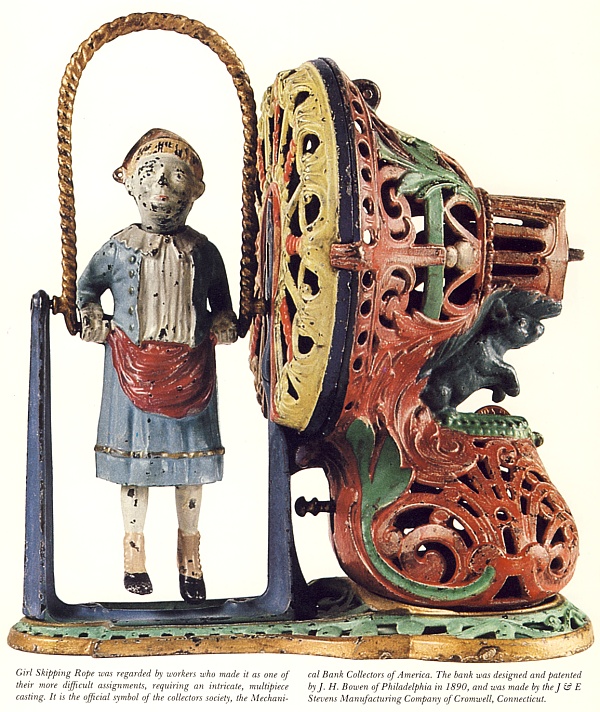
Girl Skipping Rope was regarded by workers who made it as one of their
more difficult assignments, requiring an intricate, multipiece casting.
It is the official symbol of the collectors society, the Mechanical Bank
Collectors of America. The bank was designed and patented by J. H. Bowen
of Philadelphia in 1890, and was made by the J & E Stevens Manufacturing
Company of Cromwell, Connecticut.

The Clown
and Globe bank, which dates from around 1890, was produced in great
quantity and is relatively easy to find. When activated, the clown
performs a handstand.
 The
Lady Columbine, a stock pantomime character,
dances around a clown and her partner, Harlequin, on this 1906 bank. The
Lady Columbine, a stock pantomime character,
dances around a clown and her partner, Harlequin, on this 1906 bank.
In this Mikado bank a Japanese figure moves the coin between cymbals, as
in a shell game, and always wins for the bank.
Portraying a Biblical tale, the great whale on this 1890 pedestal bank
coughs up a happy Jonah on receipt of a coin.
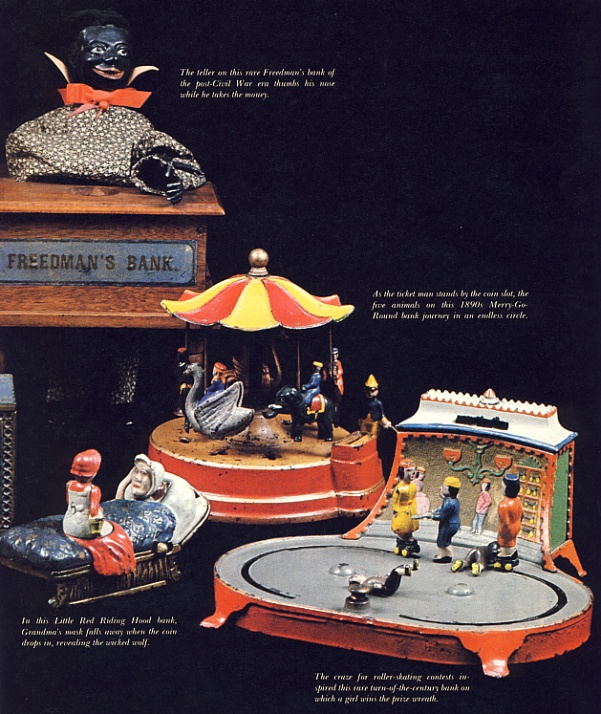
The teller on this rare Freedman's bank of the post-Civil War era thumbs
his nose while he takes the money.
As the ticket man stands by the coin slot, the five animals on this
1890s Merry-Go-Round bank journey in an endless circle.
In this Little Red Riding Hood bank, Grandma's mask falls away when the
coin drops in, revealing the wicked wolf.
The craze for roller-skating contests inspired this rare
turn-of-the-century bank on which a girl wins the prize wreath.

This bank shows the infamous William Tweed, boss of the Tammany Hall,
the political club that ruled New York City in the 19th Century and
milked millions from public funds. The bank is operated by handing Tweed
a coin. He then pockets it while nodding his thanks. A clue to the age
of the Tammany bank, invented by Russel Frisbie, is provided by patent
drawings issued in 1875. Accompanied by an explanation of the mechanism,
they were meant to prevent copying, a common practice in the freebooting
days of the late 19th Century.
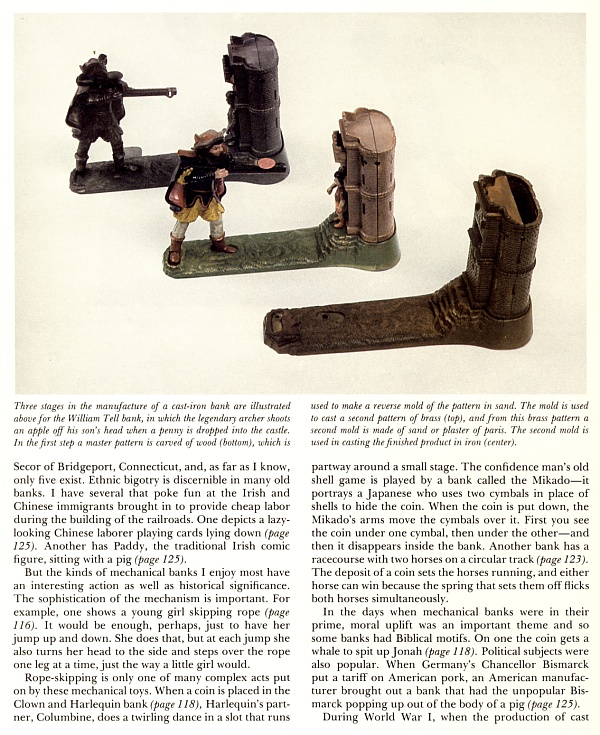
Three
stages in the manufacture of a cast-iron bank are illustrated above for
William Tell bank, in which the legendary archer shoots an apple off his
son's head when a penny is dropped into the castle. In the first step a
master pattern is carved of wood (bottom), which is used to make a
reverse mold of the pattern in sand. The mold is used to cast a second
pattern of brass (top), and from this brass pattern a second mold is
made of sand or plaster of paris. The second mold is used in casting the
finished product in iron (center).
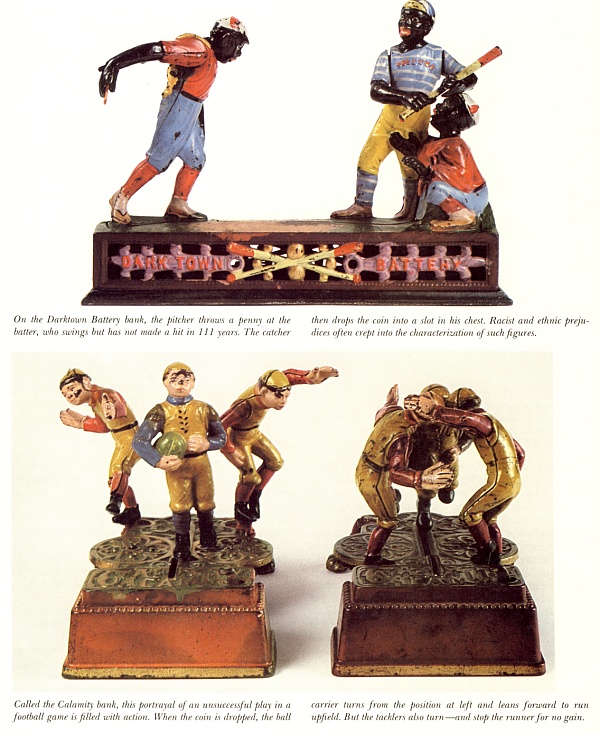
On the Darktown Battery bank, the pitcher throws a penny at the batter,
who swings but has not made a hit in 111 years. The catcher then drops
the coin into a slot in his chest. Racist and ethnic prejudices often
crept into the characterization of such figures.
Called the Calamity bank, this portrayal of an unsuccessful play in a
football game is filled with action. When the coin is dropped, the ball
carrier turns from the position at left and leans forward to run upfield.
But the tacklers also turn — and stop the runner for no gain.
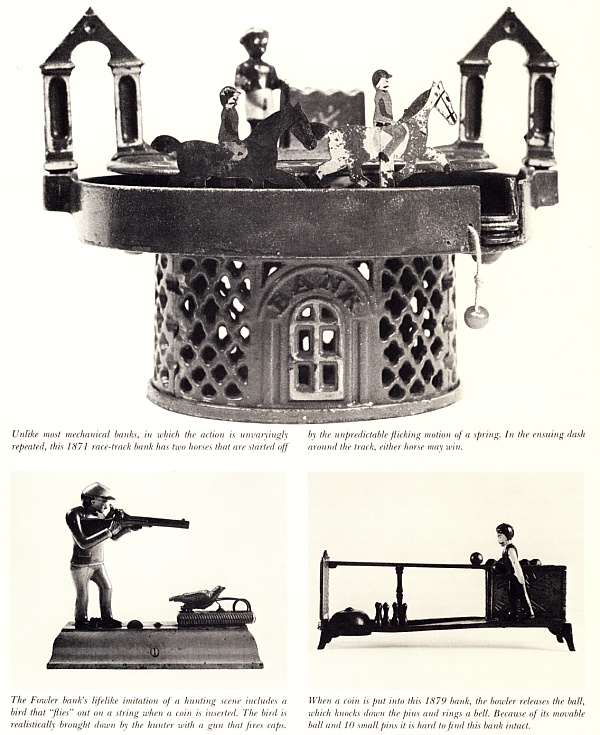
Unlike
most mechanical banks, in which the action is unvaryingly repeated, this
1871 race-track bank has two horses that are started off by the
unpredictable motion of a spring. In the ensuing dash around the track,
either horse may win.
The Fowler bank's lifelike imitation of a hunting scene includes a bird
that "flies" out on a string when a coin is inserted. The bird is
realistically brought down by the hunter with a gun that fires caps.
When a coin is put into this 1879 bank, the bowler releases the ball,
which knocks down the pins and rings a bell. Because of its movable ball
and 10 small pins it is hard to find this bank intact.
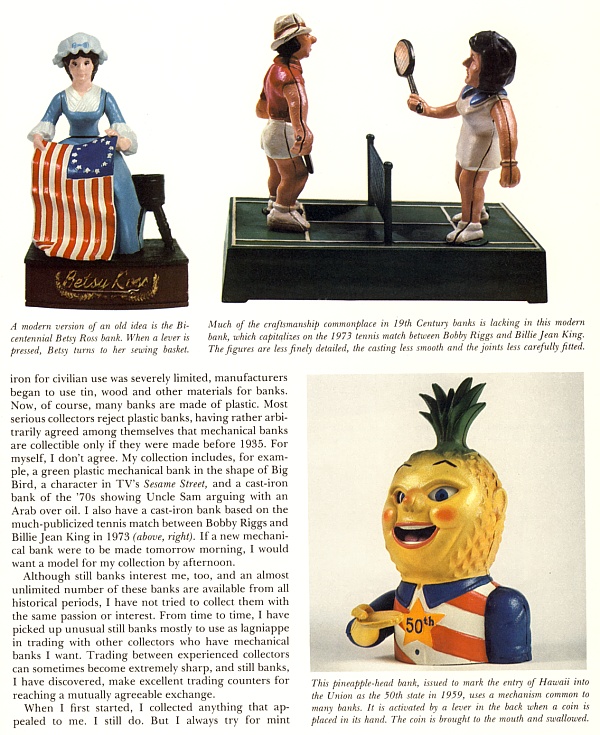
A modern
version of an old idea is Bicentennial Betsy Ross Bank. When a lever is
pressed, Betsy turns to her sewing basket.
Much of the craftsmanship commonplace in 19th Century banks is lacking
in this modern bank, which capitalizes on the 1973 tennis match between
Bobby Riggs and Billie Jean King. The figures are less finely detailed,
the casting less smooth and the joints less carefully fitted.
This pineapple-head bank, issued to mark the entry of Hawaii into the
Union as the 50th state in 1959, uses a mechanism common to many banks.
It is activated by a lever in the back when a coin is placed in its
hand. The coin is brought to the mouth and swallowed.
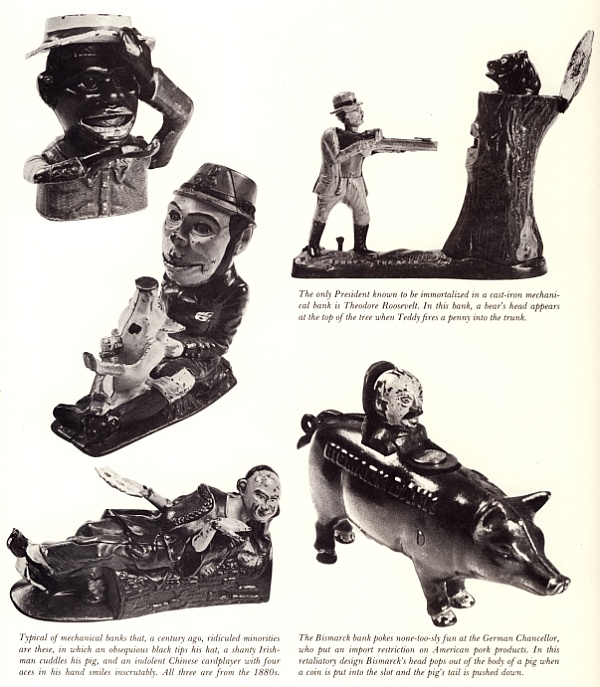
The only President known to be immortalized in a cast-iron mechanical
bank is Theodore Roosevelt. In this bank, a bear's head appears at the
top of the tree when Teddy fires a penny into the trunk.
Typical of mechanical banks that, a century ago, ridiculed minorities
are these, in which an obsequious black tips his hat, a shanty Irishman
cuddles his pig, and an indolent Chinese cardplayer with four aces in
his hand smiles inscrutably. All three are from the 1880s.
The Bismarck bank pokes none-too-sly fun at the German Chancellor, who
put an import restriction on American pork products. In this retaliatory
design Bismarck's head pops out of the body of a pig when a coin is put
into the slot and the pig's tail is pushed down.
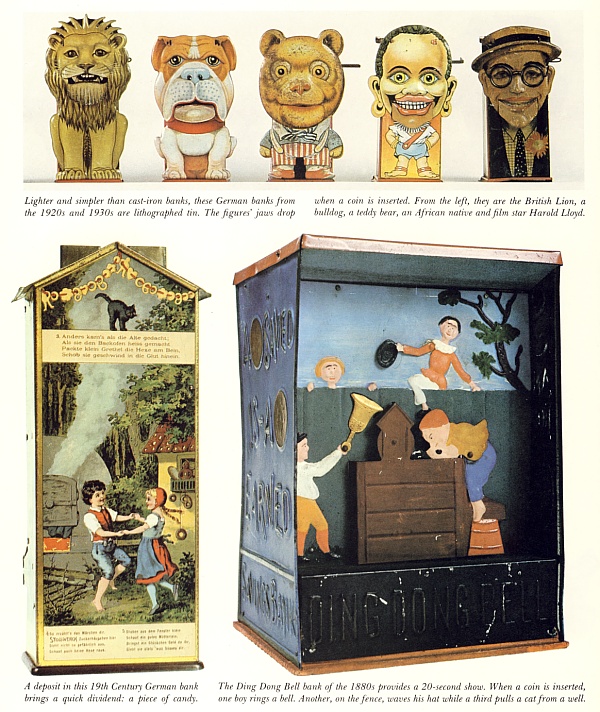
Lighter and simpler than cast-iron banks, these German banks from the
1920's and 1930's are lithographed tin. The figures' jaws drop when a
coin is inserted. From the left, they are the British Lion, a bulldog, a
teddy bear, an African native and film star Harold Lloyd.
A deposit in this 19th Century German bank brings a quick dividend: a
piece of candy.
The Ding Dong Bell bank of 1880s provides a 20-second show. When a coin
is inserted, one boy rings a bell, Another, on the fence, waves his hat
while a third pulls a cat from a well.
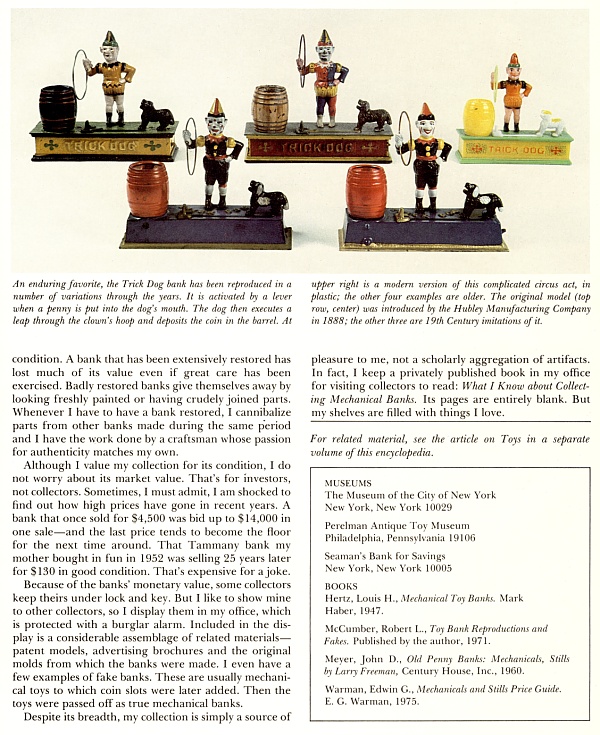
An enduring favorite, the Trick Dog bank has been reproduced in a number
of variations through the years. It is activated by a lever when a penny
is put into the dog's mouth. The dog then executes a leap through the
clown's hoop and deposits the coin in the barrel. At upper right is a
modern version of this complicated circus act, in plastic; the other
four examples are older. The original model (top row, center) was
introduced by the Hubley Manufacturing Company in 1888; the other three
are 19th Century imitations of it.
Girl Skipping Rope was regarded by workers who made it as one of their
more difficult assignments, requiring an intricate, multi-piece
casting. It is the official symbol of the collectors society, the
Mechanical Bank Collectors of America. The bank was designed and
patented by J. H. Bowen of Philadelphia in 1890, and was made by the J &
E Stevens Manufacturing Company of Cromwell, Connecticut.
|